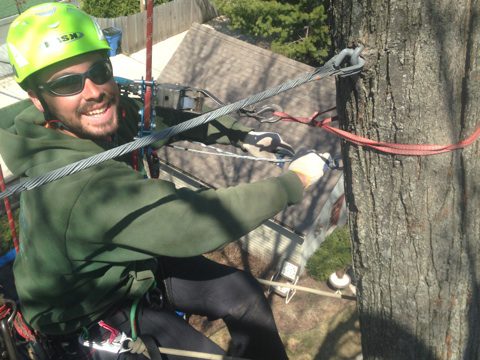Could Cabling be an Option?
Written by: Certified Master Arborist, Ron Gumz
Posted: 2021 | Cabling | Summer
Many factors influence a tree’s ability to remain standing tall. The beauty of trees and the shade which they provide from the hot summer sun beckons us to help maintain what has taken so long to develop. We can improve a tree’s longevity by first recognizing issues that predispose a tree for failure, then take action to reduce that risk of failure.
The objectives for pruning young trees include improving branch structure and spacing. Using a trained eye while pruning attends to current branch conditions that may become problematic in the future, creating a stronger structure in its maturity. Pruning a tree, especially while young, provides the best way to help avoid future structural weaknesses in a tree.
Unfortunately, not all trees have been pruned to help avoid these issues. When problems, like included bark (which are often recognized by V-shaped branch unions) or co-dominant branches exist, then additional support systems may be needed for the major limbs of a tree. Weak branch unions, often containing included bark, are much more likely to fail during a storm event. These unions benefit significantly from a cabling support system once pruning alone is not a good option for reducing the risk of failure.
One or multiple cables installed in a tree could be the right solution when trying to preserve a tree. Cables are generally installed in the upper half of the tree. Due to the height and the small diameter of the cable(s), they often blend into the tree’s branches making them challenging to see from the ground! For best results, cabling along with pruning improves the tree’s overall condition.
In addition to cabling, split limbs or unions are addressed using bracing. Bracing uses a bolt or bolts to provide additional support. Most often, bracing is combined with a cable system to create the proper support for a tree. Longitudinal splits in a limb or branch can use appropriately sized bolts installed at the split to increase support preserving a limb that may otherwise need to be taken off.
Support systems do not correct the original weakness which will still be present. Cabling and bracing systems use mechanical advantage to limit movement of the tree weakness. Once installed, a support system will be there for the remainder of the tree’s life. This support hardware needs to be monitored for wear or any loosened parts during its life. As the system ages, new systems may need to be installed to replace an aging, original cable. If you are thinking your tree or trees may need some additional structural support, check with your ISA Certified Arborist at Wachtel Tree Science to create the best solution for you!





